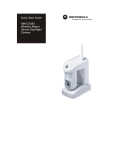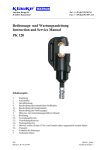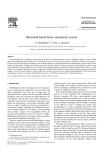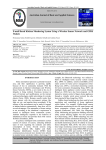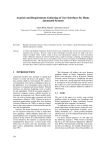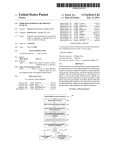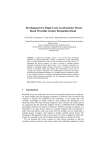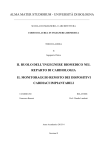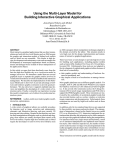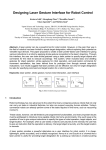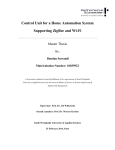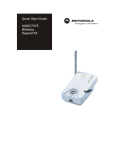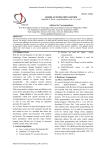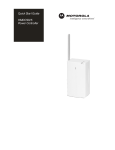Download a study on remote home monitoring using different
Transcript
ISSN 2320 - 2602 Volume 3, No.2, February 2014 International Journal of Advances in Computer Science and Technology Available Online at http://warse.org/pdfs/2014/ijacst14322014.pdf Jyothis T.S et al., International Journal of Advances in Computer Science and Technology, 3(2), February 2014, 129 - 135 A STUDY ON REMOTE HOME MONITORING USING DIFFERENT TECHNOLOGIES ABSTRACT house without a home automation system that has a wide range of applications from the remote burglar alarm and hi-tech security gates, to an automated air conditioning system that maintains the temperature at a predefined value. Automation is the use of control systems and internet technology to control equipment, industrial machinery and processes, reducing the need for human intervention. Home automation system describes the functionality that provided by the controlling home. The control system is a computerized, intelligent network for electronic devices, designed to monitor and control the mechanical and lighting systems of a home. The Home automation system (HAS), core functionality keeps the building climate within a specific range and monitors system performance and device failures and provides email and text notifications to home owner. The HAS functionality improves building energy and maintenance costs when compared to a non-controlled building. Home automation system includes all that a building automation provides like door and window controls. But there exists some difference in that home automation emphasizes more on comforts through ease of operation. The types of home automation systems based on their control systems are: The paper presents a review on different technologies that exist today and how these technologies are used for home monitoring and automation. Recently we have seen that there are various demerits while using network based home automation. The paper considers these problems with their implementation and discusses on possible solutions through various other network technologies, indicating various measures to optimize the use of such systems. The main reason for the need of home monitoring is that, these days home owners are mainly working couples. So in order to protect their homes from intruders, detection of any form of abnormalities is required. This paper makes a study on following factors security, reliability, robustness and price, which are considered to determine the technology. KEYWORDS Remote Monitoring, Home Automation, Different Standards, Network Technologies. 1. INTRODUCTION [A] HOME AUTOMATION Home automation is often referred as smart home. Today, we can hardly find a 129 Jyothis T.S et al., International Journal of Advances in Computer Science and Technology, 3(2), February 2014, 129 - 135 1. Individual Control Systems 2. Distributed Control Systems 4. Internet Protocol control system Internet Protocol (IP) control home automation system uses the internet gives each device under its own control an Internet Protocol address and creates a local area network (LAN) in the home. Hence, the home can be interacted with over the internet with possibility of video streaming and real-time control systems. Individual Control Systems Each device like the heater or the air conditioner will have an independent control dedicated to it. Distributed Control Systems The main feature is that these type of systems are used in emergency shut-down. In this system you can preset or change the control parameters of several similar devices, for example, the thermostat of several air conditioners and their ON/OFF timings. [B] ZIGBEE STANDARD ZigBee is a specification for a suite of high level communication protocols using small, low-power digital radios based on the IEEE 802.15.4 standard for wireless personal area networks (PAN), such as wireless headphones connected with cell phones via short range radio. The technology defined by the ZigBee specification is intended to be simpler and less expensive than other PAN. ZigBee had been targeted at radio frequency (RF) applications that require a low data rate, long battery life, and secure networking. ZigBee operates in the industrial, scientific and medical (ISM) radio bands especially at 868 MHz in Europe and 2.4 GHz in most jurisdictions worldwide. ZigBee chip vendors typically sell integrated radios and microcontrollers with between 60K and 128K flash memory. Radios are also available as stand-alone to be used with any microprocessor or microcontroller. Generally, the chip vendors offer the ZigBee software stack. The types of home automation systems based on the carrier mode are: 1. Power line carrier Systems The least expensive type of home automation system operates over the home's existing wiring, or power line carrier. 2. Wireless systems The available wireless home automation system utilizes radio frequency technology. It’s often used to operate lights, usually in conjunction with a hardwired lighting control system. 3. Hardwired systems The hardwired home control systems are the most reliable and expensive. These systems can operate over high-grade communications cable such as their own proprietary bus cable. Hard wired systems can perform more tasks at a time and do them quickly and reliably, making them ideal for larger homes. It integrate more systems in the home, effectively trying together indoor and outdoor lighting, audio and video equipment, security system. [C] BLUETOOTH Bluetooth is being preferred mainly due capability. Bluetooth with globally available frequencies of 2400Hz is able to 130 Jyothis T.S et al., International Journal of Advances in Computer Science and Technology, 3(2), February 2014, 129 - 135 provide connectivity up to 100 meters at speed of approximately 3Mbps depending on the Bluetooth device class [1]. In addition, a Bluetooth master device is able to connect up to seven devices in piconet network. A master Bluetooth device can communicate with a maximum of seven devices in a piconet (an ad-hoc computer network), though not all devices reach this limit. The devices can two switch roles the slave can become the master The Bluetooth Core Specification provides the connection to two or more piconets to form a scatter net, in this certain devices simultaneously play the master role in one piconet and the slave role in another. For any time interval, data can be transferred between the master and one other device, suppose to listen in each receive slot, being a master is a lighter burden than being a slave. Being a master of seven slaves is easy, being a slave of more than one master is difficult. can be allocated to a user or several active users can share a single time slot, where uplink and downlink are allocated separately. The radio resources is been shared dynamically between sound and data services as a function of traffic load and operator preference. Various radio channel coding schemes are specified to allow bitrates from 9 Kbs to 1 to more than 150 Kbs. GPRS fast reservation is designed to start packet transmission within 1s. GPRS security functionality is considered equivalent to the existing GSM security, whereas ciphering algorithm is optimized for packet transmission. This allows information to be delivered more quickly and efficiently, GPRS is a relatively inexpensive mobile data service compared to Short Message Service (SMS) and Circuit Switched Data. An excellent survey on GPRS can be found about GPRS architecture and air interface. 2. RELATED WORKS [D] GPRS ZigBee-Based System GPRS, new radio channels are predefined, and the allocation of these channels is flexible and reliable, one to eight timeslots Home Automation There are many definitions of home automation available in the literature [8] 131 Jyothis T.S et al., International Journal of Advances in Computer Science and Technology, 3(2), February 2014, 129 - 135 describes home automation as the introduction of technology within the same home to enhance the quality of life of occupants, through the provision of different services such as multimedia entertainment and energy conservation has continued to receive much attention in networking. [9] developed a Java based home automation system. An embedded board connected to all the home automation system and through integration with a personal computer (PC) based web server, provided remote access to the system. The use of Java technology, which incorporates built-in network security features, produces a secure solution. However, the system requires an intrusive and expensive wired installation and the use of a high end PC. [10] introduced a Bluetooth based home automation system, of a controller and a number of subcontrollers. Moreover the sharing of a Bluetooth module between numerous devices have disadvantage of incurring an access delay. [11] introduced a phone based remote controller for home and office automation. The system differs in all communications occur over a fixed telephone line and not over the Internet. The system can be accessed through any telephone that supports DTMF. The disadvantages of this system are three layered: users are not provided with a GUI, users have to remember the access code, and they also have to remember which buttons to press for the control of connected devices. [12] Proposed a novel control network, using hand gestures. As depicted in Figure 1, the ZigBee system consists of four steps. Remote user can access the system via the Internet. The remote user’s communications traverse the internet until they reach the home network. These are then wirelessly transmitted to the Home Gateway using the homes Wi-Fi network. The Home Gateway is integrated with a virtual home. These communications are checked and processed by the home gateway and virtual home. This checking process involves communication with the home networks coordinator, which is integrated with the home’s device database and contains the status of all connected devices. Once checked, communications are sent to the real home automation system and the respective device. Additionally, a local ZigBee based remote control can be used to directly control connected devices. Bluetooth system based home automation Bluetooth is being chosen with its suitable capability. Bluetooth with globally available frequencies of 2400Hz is able to provide connectivity up to 100 meters at speed of up to 3Mbps depending on the Bluetooth device [1]. In addition, a Bluetooth master device is able to connect up to 7 devices in piconet network. 132 Jyothis T.S et al., International Journal of Advances in Computer Science and Technology, 3(2), February 2014, 129 - 135 In figure 2, [1] illustrates the layout for the graphical user interface using the implementation of ARM9.Wince6.0 based device control with the help of Bluetooth. For this one ARM9 is required in the transmitter section. In the receiver section two devices are interfaced to microcontroller with Bluetooth module. User responsibility is to develop one application (GUI) in ARM9 with .net that is used to send commands. With Bluetooth. In the receiver side Bluetooth module is interfaced to the controller to transreceive the data from the ARM9 processor. Based on that data microcontroller will decide the devices operation like on/off the devices and lock/unlock the door. presents a compactable wireless home monitoring system using a GPRS. The GPRS modem has an inbuilt microcontroller in it and so it is called as a MicroGPRS. This unit consists of many analog and digital I/O ports and a GPRS modem associated with that. It also has a data acquisition unit in that so no need programming is used in the ports. Only need is to set the threshold parameter which has to be measured. To the input of Micro-GPRS modem we are attaching several sensors. The sensors will sense the different parameters from the home surroundings. The threshold parameters are already configured in the micro GPRS modem. In figure 3, [15] when the detected parameters are above the threshold level the modem will send a message which describes the status of sensor to an internet based server. The server then sends message to the home owner about the abnormality. Also the system utilizes the GIS to display the exact location of the monitored house as well as the GRPS-based distributed home monitoring using Internet-based Geographical Information System In recent years, the home environment has seen a rapid introduction of network enabled digital technology. The paper 133 Jyothis T.S et al., International Journal of Advances in Computer Science and Technology, 3(2), February 2014, 129 - 135 sensed parameters. The system detects accidents or abnormal behavior or events when the monitored physical phenomena exceed a certain level. When such condition happens it sends SMS to the home owner. In addition to this the home owners can be able to check their home status by sending a message to modem. The modem will reply by indicating the status of the home. The system must have to be reliable during the time of its operation. It will go to sleep mode when there is no deviation from the sensed value to that of threshold value. The system should accept only valid messages and only responds to registered users. Moreover the response time of the system is only 1 minute. It will immediately respond whenever it finds an abnormality condition. This technology offers new and exciting opportunities to increase the connectivity of devices within the home for the purpose of home automation. the rapid expansion of the Internet, is to add potential for the remote control and monitoring, web- based GIS and the availability of integrated General Packet Radio Service (GPRS)/Global Positioning Systems (GPS) modem have enabled the development of embedded stand-alone home monitoring systems. 3. COMPARISON STUDY The following table, Table 1 shows the comparison study. STANDARDS IEEE STANDARD FREQUENCY BAND NOMINAL RANGE MAX:SIGNAL RATE CHANNEL BANDWIDTH BLUETOOTH ZIGBEE 802.15.1 802.15.4 2.4 GHz 868/915 MHz; 2.4 GHz 10 m 10 - 100 m 1 Mb/s 250 Kb/s 1 MHz 0.3/0.6 MHz; 2 MHz Table 1. Comparing technologies From this we can conclude that Zigbee based home automation is better. But it has its own limitations. 134 Jyothis T.S et al., International Journal of Advances in Computer Science and Technology, 3(2), February 2014, 129 - 135 [8] A ZigBee-Based Home Automation System Khusvinder Gill, Shuang-Hua Yang, Fang Yao, and Xin Lu. [9] A. R. Al-Ali and M. Al-Rousan, "Javabased home automation system", IEEE Transactions on Consumer Electronics, vol. 50, no. 2, pp. 498-504, 2004. [10] H. Ardam and I. Coskun, "A remote controller for home and office appliances by telephone", IEEE Transactions on Consumer Electronics, vol. 44, no. 4, pp. 1291-1297, 1998. [11] T. Baudel and M. Beaudouin-Lafon, "Charade: remote control of objects using free-hand gestures", Communications of the ACM, vol. 36, no. 7, pp. 28-35, 1993. [12] T. Saito, I. Tomoda, Y. Takabatake, J. Ami and K. Teramoto, "Home Gateway Architecture And Its Implementation", IEEE International Conference on Consumer Electronics, pp. 194-195, 2000. [13] N. Kushiro, S. Suzuki, M. Nakata, H. Takahara and M. Inoue, "Integrated home gateway controller for home energy management system", IEEE International Conference on Consumer Electronics, pp. 386387, 2003. [14] S. Ok and H. Park, "Implementation of initial provisioning function for home gateway based on open service gateway initiative platform", The 8th International Conference on Advanced Communication Technology, pp. 1517-1520, 2006.. [15] GRPS-Based Distributed HomeMonitoring Using Internet-Based Geographical Information System A. R. Al-Ali, Imran A. Zualkernan, Assia Lasfer, Alaa Chreide, and Hadel Abu Ouda 4. CONCLUSION The trend of standardization in home automation is becoming the most important factor to introduce an automated environment in our neighborhoods. Since this is a new field of science, the results of this review paper are likely to be useful for future enhancements. The completion of a whole cycle of control between a remote device and the home will be critical for the success of home automation. This paper introduces a new technology which helps people to monitor the home and understand whether something harm happened to the home such as intruders attack, fire, flooding or gas leaks using internet. These technologies offer new and exciting opportunities to increase the connectivity of devices within the home for the purpose of home automation. Moreover, with the rapid expansion of the Internet, there is the added potential based on the remote control and monitoring. REFERENCES [1] Bluetooth based home automation system N. Sriskanthan, F. Tan, A. Karande. [2] The official Bluetooth website from Bluetooth SIG www.Bluetooth.com, Date viewed: March 21, 2001, Bluetooth Specification Version 1.1. [3] Bluetooth Committee, Specifications of the Bluetooth System (Core), December 1999, V1.0B. [4] Home System Specification, EHS, 1997. [5] Ericsson Mobile Communications AB, User Manual—Bluetooth PC Reference Stack, 1543 VNX 2/901 184 Uen Version R1a, April 2000. [6] I.S. McKenzie, The 8051 Microcontroller, Prentice Hall, Upper Saddler River, NJ, 1999. [7] Phillips Semiconductors, 87C51 8-bit Microcontroller Data Sheet, 1999. 135







